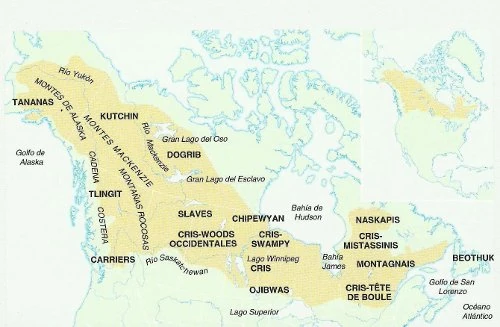


A large forest surrounded by countless lakes, ponds, streams and rivers stretches north of the northeastern meadows and forests and around Hudson Bay.
In rocky and infertile soils, resilient pine trees, piceas, and oaks can survive, and in protected areas, trembling oaks, sauces, and beetles can withstand long and terribly cold winters. Liquids and mosses cling to trees, stones and soil everywhere. To the west, the forest turns into cold tundra. Although the sub-Arctic summers become warm, the nearby tundra and forests are not a good season because there are many mosquitoes, mosquitos and other insects that bite in the air. The soil remains frozen at all times due to the thin layer melted by the sun.
Most of the people who lived in this desolate territory devoted themselves to hunting, fishing and going out in small family groups to find food.
The villages east of the Rockies, such as the Chipewyan, the Dogrib, the Kutchin (gwich'in) and others, used the Atapascan language. The Algonquin-speaking peoples, such as the Cris, the Ojibwas, the Naskapis and the Montagnais, lived in the granite landscape devastated by glaciers that surrounded the Hudson Bay and extended eastward to the Atlantic.
The prey was the target of hunter groups. To ensure fish supply, they lived on the shores of the lakes during the winter and built blankets or small tipis. In addition, they could move on foot using rackets or on trolleys and tobogans. Some groups knew the locations of hunting and family traps and returned there every year for hunting, fishing or gathering. Catching animals such as caribou, alce and others that left footprints on the snow was easy. In canoes made of beetle bark, they traveled rivers and lakes while the spring dew crushed the land.
Caribou and reindeer were the main food for life in the northern subarctic region. All parts of these animals were used by the peoples for different purposes, such as caribou leather types and tools and weapons made with bones and cornments. Although the caribou spends winter in small groups on the borders of tree vegetation, in early spring they migrate to the reproductive areas of the tundra, which extends to the north. They return to the south with their offspring during the short northern summer. During the journey, they are attacked by wolves and, at the intersections of rivers, humans put them in danger.
In addition, they were dedicated to the hunting of animals such as alces, almizclerous oxen, deer, animals with fur such as castors, visons, hares and nutries, as well as bison in the forests that were located to the north of the plains. There were Rocky Goats in the mountains of the western Yukon and Alaska. Pork spines lived in the forests and provided meat and puffs for dying, flattening, and adorning clothing and accessories. Non-domesticated birds increased in number. In the southern forests, the most common vegetable foods were berries, roots, wild rice and the soft inner crust of the algae. The northernmost Chipewyan lived mainly on meat and fish. Despite isolation and difficulties, the northern groups managed to maintain family ties, exchange wives, gather to organize caribou hunting expeditions and establish connections through the trade of metals such as copper, silicone and quartzite, which were essential for the creation of tools.
Sub-Arctic women are experts in hunting small animals. They are also traditionally engaged in peeling the caribou, pleasing the skins, peeling and preparing the meat.
 Native American Cultures: Myths and magic
Native American Cultures: Myths and magic
You can purchase this book on Amazon.
This book challenges deep-seated stereotypes and offers an enriching perspective that contributes to a more comprehensive and respectful appreciation of the indigenous peoples of North America. Through an understanding of their myths and beliefs, we are taking an important step toward cultural reconciliation and the recognition of the diversity that has enriched the history of this continent.
These mythical stories, many of them linked to the literary genre of fantasy, reveal a world where the divine and the human intertwine in narratives that explain the cosmic order, creation, and the fundamental structure of the universe. Discover how these sacred tales bear witness to the deep connection of the natives with nature and spirituality.
Native Americans: Population and Territories
Native Americans: Cultures, customs, worldview
Traditions, myths, stories and legends